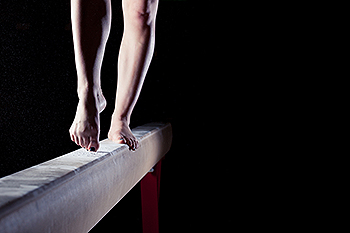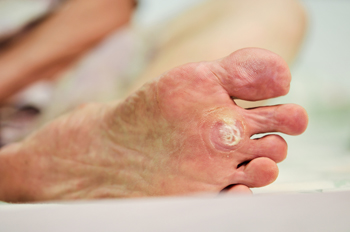Blog
Items filtered by date: August 2022
Tuesday, 30 August 2022 00:00
Is There a Connection Between Poor Circulation and Toenail Fungus?

Onychomycosis, otherwise known as toenail fungus, is an infection of the toenails. This type of fungus is found in moist environments, consisting of public swimming pools, shower room floors, and locker rooms. The fungus enters the body through small cracks in the skin on the feet, and it is wise to wear appropriate shoes while in these types of areas. It is a common ailment, and generally causes no pain, although it can appear to be unsightly. The symptoms that are often associated with this condition often include yellowed nails that have become thick and brittle, and may begin to crumble. It may be more prevalent among the older population, and can be difficult to treat. Research has shown that there may be a correlation between toenail fungus and reduced blood flow, and it may help to increase circulation as part of the antidote for toenail fungus. This can be improved by consuming a healthy diet that is made up of low-fat and plant based foods, which may help overall health. Toenail fungus can be a stubborn condition, and can gradually worsen if left untreated. It is strongly advised that you consult with a podiatrist if you are afflicted with this ailment who can guide you toward the correct treatment options.
If left untreated, toenail fungus may spread to other toenails, skin, or even fingernails. If you suspect you have toenail fungus it is important to seek treatment right away. For more information about treatment, contact one of the podiatrists of JE Foot & Ankle Associates. Our doctors can provide the care you need to keep you pain-free and on your feet.
Symptoms
- Warped or oddly shaped nails
- Yellowish nails
- Loose/separated nail
- Buildup of bits and pieces of nail fragments under the nail
- Brittle, broken, thickened nail
Treatment
If self-care strategies and over-the-counter medications does not help your fungus, your podiatrist may give you a prescription drug instead. Even if you find relief from your toenail fungus symptoms, you may experience a repeat infection in the future.
Prevention
In order to prevent getting toenail fungus in the future, you should always make sure to wash your feet with soap and water. After washing, it is important to dry your feet thoroughly especially in between the toes. When trimming your toenails, be sure to trim straight across instead of in a rounded shape. It is crucial not to cover up discolored nails with nail polish because that will prevent your nail from being able to “breathe”.
In some cases, surgical procedure may be needed to remove the toenail fungus. Consult with your podiatrist about the best treatment options for your case of toenail fungus.
If you have any questions, please feel free to contact one of our offices located in Fleming Island and Palm Coast, FL . We offer the newest diagnostic and treatment technologies for all your foot care needs.
Tuesday, 23 August 2022 00:00
Types of Foot Fractures

One of the most detrimental conditions to negatively impact the health of the feet is broken or fractured feet. An individual has a fracture of their feet when a bone breaks. If you have a fractured foot, you may experience pain in and around the feet. Your affected foot might even appear bruised, and it could be difficult for you to put weight on it. Generally speaking, there are two main types of broken feet. First, you can develop what is known as a full foot fracture. This condition is caused by some type of one-time injury. Commonly, individuals can develop a full foot fracture by dropping a significantly heavy object directly onto their foot. If you have a full foot injury, the various muscles and tissues that surround the foot might be injured or affected. However, this is not always the case with certain full foot injuries. Second, you can develop what is known as a stress fracture in the foot. This type of injury occurs over an extended period of time when a specific part of the foot undergoes repeated stress and overuse. These two types of foot fractures have different causes, yet they can share some of the same symptoms. If you believe that you may have broken or fractured your foot, you can seek guidance from a podiatrist who can help you identify and address the problem.
A broken foot requires immediate medical attention and treatment. If you need your feet checked, contact one of the podiatrists from JE Foot & Ankle Associates. Our doctors can provide the care you need to keep you pain-free and on your feet.
Broken Foot Causes, Symptoms, and Treatment
A broken foot is caused by one of the bones in the foot typically breaking when bended, crushed, or stretched beyond its natural capabilities. Usually the location of the fracture indicates how the break occurred, whether it was through an object, fall, or any other type of injury.
Common Symptoms of Broken Feet:
- Bruising
- Pain
- Redness
- Swelling
- Blue in color
- Numbness
- Cold
- Misshapen
- Cuts
- Deformities
Those that suspect they have a broken foot shoot seek urgent medical attention where a medical professional could diagnose the severity.
Treatment for broken bones varies depending on the cause, severity and location. Some will require the use of splints, casts or crutches while others could even involve surgery to repair the broken bones. Personal care includes the use of ice and keeping the foot stabilized and elevated.
If you have any questions please feel free to contact one of our offices located in Fleming Island and Palm Coast, FL . We offer the newest diagnostic and treatment technologies for all your foot and ankle needs.
Tuesday, 16 August 2022 00:00
Gymnastics Ankle and Foot Injuries

Ankle and foot injuries are common among gymnasts throughout their careers because of the high impact on hard floors and repetition required in the sport. Research shows that over half of injuries incurred by gymnasts are in the hip, knee, ankle, and foot. Overuse injuries, like ankle sprains, are particularly prevalent among gymnasts. However, more severe injuries, such as tendon ruptures and fractures are common as well. Impact injuries to the feet and ankles come from tumbling, punching, bounding, sprinting, and/or landing in gymnastics. As might be expected, the forces of gymnastics generally range from 15 to 18 times one’s body weight. It can take several repetitions to master movements and short or awkward landings can lead to further injury. Also, their growth plates are wide open and vulnerable to injury. These young people are often asked to specialize in gymnastics and not participate in other sports, as well as train year-round which can have deleterious effects on their potential for injury. Prevention of injury in gymnastics can be helped by proper strength training, skill technique, and recovery. If you or your child participates in gymnastics, you might consider consulting with a podiatrist who can help develop a plan of prevention for foot and ankle injuries and be on board in case an injury of this nature is sustained.
Sports related foot and ankle injuries require proper treatment before players can go back to their regular routines. For more information, contact one of the podiatrists of JE Foot & Ankle Associates. Our doctors can provide the care you need to keep you pain-free and on your feet.
Sports Related Foot and Ankle Injuries
Foot and ankle injuries are a common occurrence when it comes to athletes of any sport. While many athletes dismiss the initial aches and pains, the truth is that ignoring potential foot and ankle injuries can lead to serious problems. As athletes continue to place pressure and strain the area further, a mild injury can turn into something as serious as a rupture and may lead to a permanent disability. There are many factors that contribute to sports related foot and ankle injuries, which include failure to warm up properly, not providing support or wearing bad footwear. Common injuries and conditions athletes face, including:
- Plantar Fasciitis
- Plantar Fasciosis
- Achilles Tendinitis
- Achilles Tendon Rupture
- Ankle Sprains
Sports related injuries are commonly treated using the RICE method. This includes rest, applying ice to the injured area, compression and elevating the ankle. More serious sprains and injuries may require surgery, which could include arthroscopic and reconstructive surgery. Rehabilitation and therapy may also be required in order to get any recovering athlete to become fully functional again. Any unusual aches and pains an athlete sustains must be evaluated by a licensed, reputable medical professional.
If you have any questions please feel free to contact one of our offices located in Fleming Island and Palm Coast, FL . We offer the newest diagnostic and treatment technologies for all your foot and ankle needs.
Wednesday, 10 August 2022 00:00
When Plantar Warts Are Painful

Plantar warts are small patches of hardened growths that can form on the bottom, or sole, of someone’s feet. These warts are spread from one person to another through the human papillomavirus (HPV). Importantly, plantar warts are significantly different from corns, which form on the top of toes in response to friction or stress. Many cases of plantar warts may not cause the patient any pain. However, there are instances in which warts might be painful. If you have a larger plantar wart that essentially splits open, this could be a sign that pain might be felt later. This is because the tissue underneath a larger plantar wart can become irritated, which might ultimately result in bleeding and pain. Additionally, plantar warts can also cause the patient pain depending on where they are located. Warts that are situated on the skin folds of the toes can be especially painful. If a wart is growing inward, typically in response to the body putting pressure on the bottoms of feet when standing, then this can also be particularly painful. Contact a podiatrist for help with your plantar warts.
Plantar warts can be very uncomfortable. If you need your feet checked, contact one of the podiatrists from JE Foot & Ankle Associates. Our doctors will assist you with all of your foot and ankle needs.
About Plantar Warts
Plantar warts are the result of HPV, or human papillomavirus, getting into open wounds on the feet. They are mostly found on the heels or balls of the feet.
While plantar warts are generally harmless, those experiencing excessive pain or those suffering from diabetes or a compromised immune system require immediate medical care. Plantar warts are easily diagnosed, usually through scraping off a bit of rough skin or by getting a biopsy.
Symptoms
- Lesions on the bottom of your feet, usually rough and grainy
- Hard or thick callused spots
- Wart seeds, which are small clotted blood vessels that look like little black spots
- Pain, discomfort, or tenderness of your feet when walking or standing
Treatment
- Freezing
- Electric tool removal
- Laser Treatment
- Topical Creams (prescription only)
- Over-the-counter medications
To help prevent developing plantar warts, avoid walking barefoot over abrasive surfaces that can cause cuts or wounds for HPV to get into. Avoiding direct contact with other warts, as well as not picking or rubbing existing warts, can help prevent the further spread of plantar warts. However, if you think you have developed plantar warts, speak to your podiatrist. He or she can diagnose the warts on your feet and recommend the appropriate treatment options.
If you have any questions please feel free to contact one of our offices located in Fleming Island and Palm Coast, FL . We offer the newest diagnostic and treatment technologies for all your foot and ankle needs.
Tuesday, 09 August 2022 00:00
Why Live with Pain and Numbness in Your Feet?
Tuesday, 02 August 2022 00:00
Numbness in the Feet During Pregnancy

It is very common for women who are pregnant to experience certain complications or discomfort in their feet. This is essentially because during a pregnancy, a woman’s body experiences bodily changes that oftentimes will have some sort of effect on the feet. One condition a woman might experience during her pregnancy is numbness in the feet. Sometimes referred to as a “pins-and-needles” feeling, numbness in the feet can be uncomfortable and make walking difficult. Numbness in the feet can occur during a woman’s pregnancy because as the fetus grows, the woman’s body gets increasingly swollen. This swelling at the ankles and throughout the lower legs can put pressure on nerves that can ultimately make the feet go numb. It is important to note that in addition to the feet, numbness can also affect a woman’s hands during her pregnancy. You can reduce the severity of the numbness by increasing blood flow and circulation to the lower legs and feet. If you are pregnant, or are planning to be, consider contacting a podiatrist who can offer you guidance on maintaining proper foot health throughout your pregnancy.
Pregnant women with swollen feet can be treated with a variety of different methods that are readily available. For more information about other cures for swollen feet during pregnancy, consult with one of the podiatrists from JE Foot & Ankle Associates. Our doctors will attend to all of your foot and ankle needs.
What Foot Problems Can Arise During Pregnancy?
One problem that can occur is overpronation, which occurs when the arch of the foot flattens and tends to roll inward. This can cause pain and discomfort in your heels while you’re walking or even just standing up, trying to support your baby.
Another problem is edema, or swelling in the extremities. This often affects the feet during pregnancy but tends to occur in the later stages.
How Can I Keep My Feet Healthy During Pregnancy?
- Wearing orthotics can provide extra support for the feet and help distribute weight evenly
- Minimize the amount of time spent walking barefoot
- Wear shoes with good arch support
- Wear shoes that allow for good circulation to the feet
- Elevate feet if you experience swelling
- Massage your feet
- Get regular, light exercise, such as walking, to promote blood circulation to the feet
If you have any questions please feel free to contact one of our offices located in Fleming Island and Palm Coast, FL . We offer the newest diagnostic and treatment technologies for all your foot and ankle needs.
Blog Archives
- May 2025
- April 2025
- March 2025
- February 2025
- January 2025
- December 2024
- November 2024
- October 2024
- September 2024
- August 2024
- July 2024
- June 2024
- May 2024
- April 2024
- March 2024
- February 2024
- January 2024
- December 2023
- November 2023
- October 2023
- September 2023
- August 2023
- July 2023
- June 2023
- May 2023
- April 2023
- March 2023
- February 2023
- January 2023
- December 2022
- November 2022
- October 2022
- September 2022
- August 2022
- July 2022
- June 2022
- May 2022
- April 2022
- March 2022
- February 2022
- January 2022
- December 2021
- November 2021
- October 2021
- September 2021
- August 2021
- July 2021
- June 2021
- May 2021
- April 2021
- March 2021
- February 2021
- January 2021
- December 2020
- November 2020
- October 2020
- September 2020
- August 2020
- July 2020
- June 2020
- May 2020
- April 2020
- March 2020
- February 2020
- January 2020
- December 2019
- November 2019
- October 2019
- September 2019

